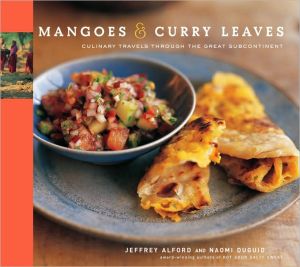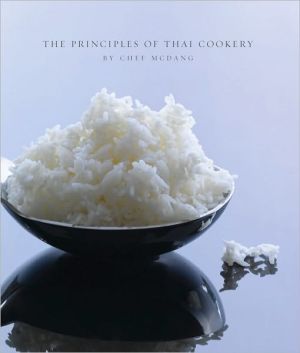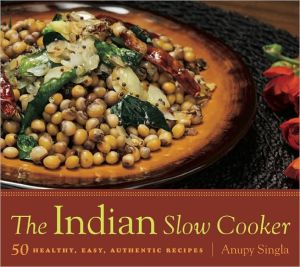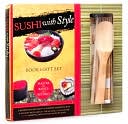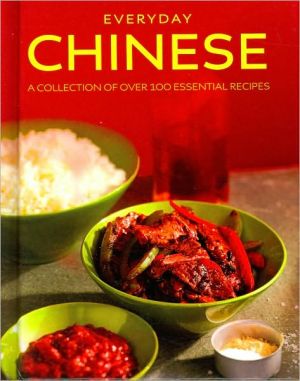Mangoes & Curry Leaves: Culinary Travels Through the Great Subcontinent
For this companion volume to the award-winning Hot Sour Salty Sweet, Jeffrey Alford and Naomi Duguid travel west from Southeast Asia to that vast landmass the colonial British called the Indian Subcontinent. It includes not just India, but extends north to Pakistan, Bangladesh, and Nepal and as far south as Sri Lanka, the island nation so devastated by the recent tsunami. For people who love food and cooking, this vast region is a source of infinite variety and eye-opening flavors. \ Home...
Search in google:
For this companion volume to the award-winning Hot Sour Salty Sweet, Jeffrey Alford and Naomi Duguid travel west from Southeast Asia to that vast landmass the colonial British called the Indian Subcontinent. It includes not just India, but extends north to Pakistan, Bangladesh, and Nepal and as far south as Sri Lanka, the island nation so devastated by the recent tsunami. For people who love food and cooking, this vast region is a source of infinite variety and eye-opening flavors. Home cooks discover the Tibetan-influenced food of Nepal, the Southeast Asian tastes of Sri Lanka, the central Asian grilled meats and clay-oven breads of the northwest frontier, the vegetarian cooking of the Hindus of southern India and of the Jain people of Gujarat. It was just twenty years ago that cooks began to understand the relationships between the multifaceted cuisines of the Mediterranean; now we can begin to do the same with the foods of the Subcontinent. Publishers Weekly With their most recent cookbook, Home Baking, the authors of Seductions of Rice and Hot Sour Salty Sweet strayed slightly from the kind of pungent Asian food that is their strength, but they're back on track with this paean to the subcontinent, which they've been visiting separately and together since the 1970s. The many dals, like soupy Easy Karnataka Chana with chickpeas and salads like Nepali Green Bean-Sesame Salad are simple and terrific. Entrees are often spicy and always authentic, like Goan Pork Vindaloo, made by rubbing a vinegar-spice paste into the meat. A chapter on street foods is full of promising tidbits, including the suggestion that readers make fried foods such as Mushroom Pakoras with Fresh Herb Chutney for guests (so long as they don't mind spending a whole lot of time in the kitchen). Reading Alford and Duguid's chatty text and headnotes is like receiving envy-inducing postcards from a college friend who never gave up backpacking-if you have the sort of friends who would be disposed to build a tandoor oven out of clay and manure or visit Arugam Bay in Sri Lanka based on a tip from a snake-bitten fellow traveler. This is a comprehensive book filled with compelling writing-a worthy addition to the couple's impressive body of work. Color and b&w photos. (On sale Nov. 20) Copyright 2005 Reed Business Information.
Mangoes & Curry Leaves \ Culinary Travels Through the Great Subcontinent\ \ By Jeffrey Alford Artisan Publishers \ Copyright © 2005 Jeffrey Alford\ All right reserved.\ ISBN: 9781579652524\ \ \ \ Chapter One \ There's a shared sensibility in the Subcontinent when it comes to matters of eating. People almost always eat using one hand (the right hand), and they very seldom use utensils. This may not sound like a big deal, but we think it is. Time after time we watch foreigners come to the Subcontinent and have a very difficult time at first, eating without utensils and using only one hand. But interestingly, almost everyone breaks through, and when they do, they are entirely converted. Eating by hand influences how food tastes and how we relate to it. It's so sensual, so direct. But when we go back home, no matter how hard we try to resist, out come the utensils. Eating is a very culture-bound tradition.\ \ One of the great pleasures of eating in the Subcontinent is that styles of eating by hand differ from place to place. When northerners eat rice, they pick it up with the tips of their fingers and then use their thumb to push the small amount of rice into their mouth. In southern regions, people eat rice using the entire hand, forming a ball of rice (approximately the size of a golf ball) by gathering the rice into their palm, flicking the wrist sideways to shape it into a mass, and finally tossing the entire ball into their mouth.\ \ As a foreigner,it's fun to watch and learn, to try to imitate (though a style doesn't come quickly). After a while, when you think you've got it down, the style itself feels somehow crucial to the food, as if that particular food has to be eaten in that particular way. And if you eat by hand, when you're finished with your meal, you still have tasty little bits on your fingers, and then later, even after you've washed your hands, there's a delicious aroma that lingers. As foreigners we find all this wonderfully addictive, and so we can only imagine how important it would feel if we'd been eating this same food in this same way all our lives, and how unsatisfying it would feel to eat with utensils.\ \ \ Recipe: Sweet Yogurt Sundae with Saffron and Pistachios\ \ Yogurt makes a simple and attractive sweet course or cooling snack-treat. This version of sweetened yogurt from Bengal is called mishti doi, doi being Bengali for "yogurt." The yogurt drains for an hour to lose its bitter whey and to thicken a little, then it is blended with jaggery (palm or crude sugar) and flavorings. Use good whole-milk yogurt, preferably organic. Serve in small bowls or tall sundae glasses and top with pistachios, or with pomegranate seeds or chopped toasted almonds.\ • Line a large sieve or colander with cheesecloth or coarse cotton.\ • Wet the cloth with water, then place the sieve or colander over a bowl. Place the yogurt in the sieve to drain for 1 hour in the refrigerator.\ • Turn the yogurt into a bowl and set aside. Use the whey for another purpose (it makes a refreshing drink and can also be used in place of lemon juice to curdle milk for making chhana and paneer), or discard.\ • If using the saffron, lightly toast the strands in a small dry skillet over medium heat, until brittle. Add the milk and cardamom or nutmeg, or if not using saffron, heat the milk and cardamom in a small saucepan; bring to a simmer, and simmer briefly, until the cardamom releases its scent (and the optional saffron gives off its color). Remove from the heat and stir in the sugar or honey until dissolved.\ • Whisk the mixture into the yogurt. Use a ladle to pour the yogurt into glasses or bowls. Top with a sprinkling of nuts or pomegranate seeds, and with a little more sugar if you wish.\ • Serves 8\ \ \ Continues... \ \ \ \ Excerpted from Mangoes & Curry Leaves by Jeffrey Alford Copyright © 2005 by Jeffrey Alford. Excerpted by permission.\ All rights reserved. No part of this excerpt may be reproduced or reprinted without permission in writing from the publisher.\ Excerpts are provided by Dial-A-Book Inc. solely for the personal use of visitors to this web site. \ \
\ From Barnes & NobleContinuing the culinary journey that they pursued in Hot Sour Salty Sweet, Jeffrey Alford and his wife, Naomi Duguid, traveled through the Indian Subcontinent. Throughout this vast region (which covers India, Pakistan, Bangladesh, Nepal, and Sri Lanka), they discovered cuisines even more diverse and versatile than they had imagined. Like its award-winning predecessor, Mangoes & Curry Leaves blends cultural background and kitchen know-how. Alford and Duguid's on-site photographs add just the right touch to this fascinating, informative book.\ \ \ \ \ Publishers WeeklyWith their most recent cookbook, Home Baking, the authors of Seductions of Rice and Hot Sour Salty Sweet strayed slightly from the kind of pungent Asian food that is their strength, but they're back on track with this paean to the subcontinent, which they've been visiting separately and together since the 1970s. The many dals, like soupy Easy Karnataka Chana with chickpeas and salads like Nepali Green Bean-Sesame Salad are simple and terrific. Entrees are often spicy and always authentic, like Goan Pork Vindaloo, made by rubbing a vinegar-spice paste into the meat. A chapter on street foods is full of promising tidbits, including the suggestion that readers make fried foods such as Mushroom Pakoras with Fresh Herb Chutney for guests (so long as they don't mind spending a whole lot of time in the kitchen). Reading Alford and Duguid's chatty text and headnotes is like receiving envy-inducing postcards from a college friend who never gave up backpacking-if you have the sort of friends who would be disposed to build a tandoor oven out of clay and manure or visit Arugam Bay in Sri Lanka based on a tip from a snake-bitten fellow traveler. This is a comprehensive book filled with compelling writing-a worthy addition to the couple's impressive body of work. Color and b&w photos. (On sale Nov. 20) Copyright 2005 Reed Business Information.\ \ \ Library JournalAlford and Duguid (Hot Sour Salty Sweet) delight readers once again with their latest culinary travelog, exploring the gastronomic cultures of the Indian subcontinent: Pakistan, India, Nepal, Bhutan, Bangladesh, Sri Lanka, and the Maldives. This beautiful tome contains more than 200 recipes and remembrances of the authors' last 30 years traveling and eating in these countries. Arranged by food type, chapters range from chutneys and breads to dals, meats, street foods, and sweets. Each recipe is introduced with a paragraph or two describing the dish or where the authors first encountered it, such as Simmered Spiced Soybeans from Nepal and Katchhi Village Potato Curry, first eaten in western India in the home of a friend. Interspersed throughout are memories of traveling and culture-visiting the chai shop, wandering through the outdoor food market, and bargaining. The black-and-white and color photographs of the food, people, and landscape, included on nearly every page, transport readers overseas. Highly recommended for all collections.-Pauline Baughman, Multnomah Cty. Lib., Portland, OR Copyright 2006 Reed Business Information.\ \
